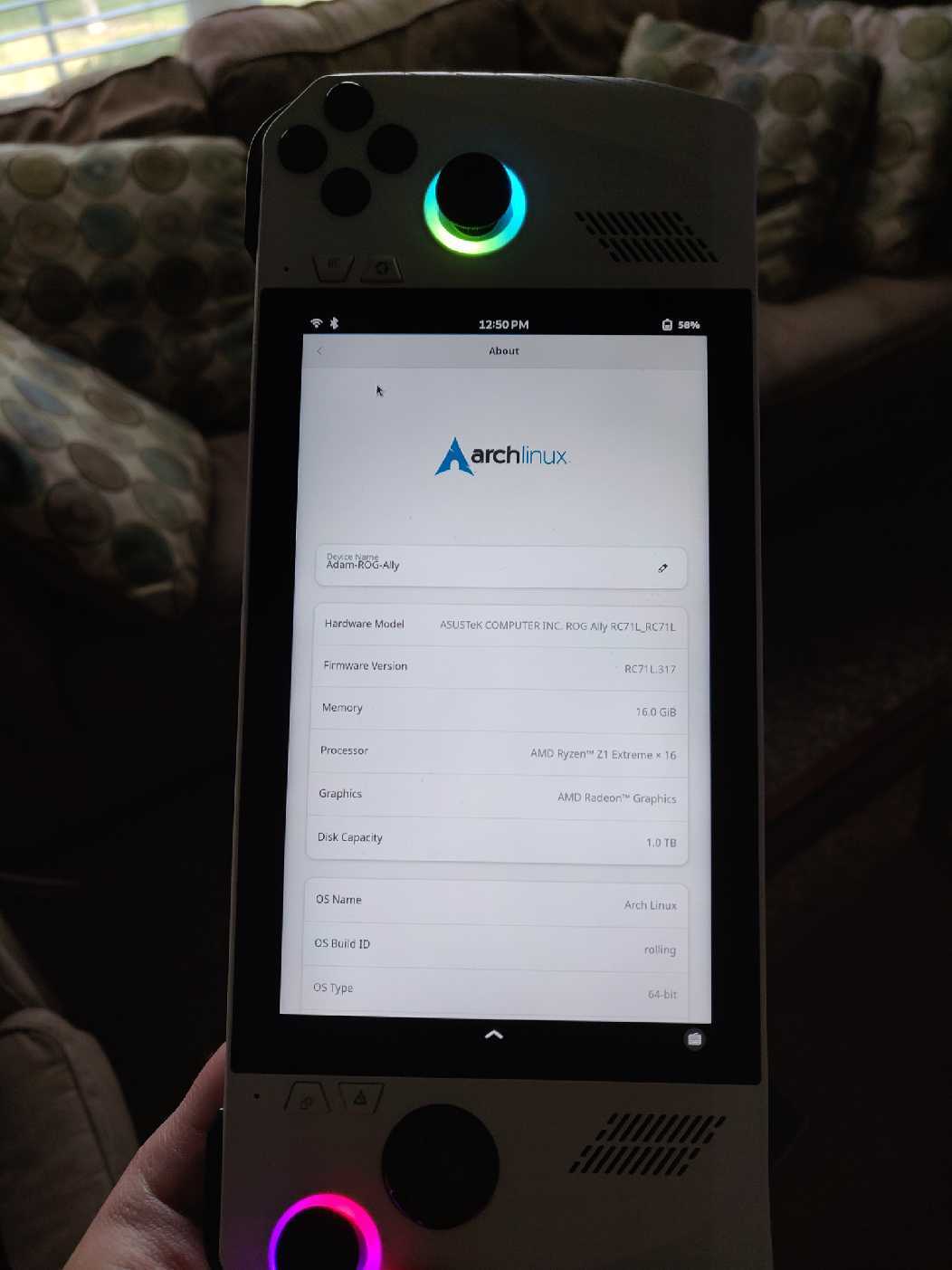Software Engineer, Linux Enthusiast, OpenRGB Developer, and Gamer
Lemmy.today Profile: https://lemmy.today/u/CalcProgrammer1
- 3 Posts
- 44 Comments

 4·5 months ago
4·5 months agoI tried daily driving a Pinephone for a while but had too many issues. My setup of choice now is to have two phones. I have a OnePlus 6 on stock Android and a OnePlus 6T with postmarketOS. Android for calls and texts as well as some apps, pmOS for experimenting with Linux, coding, remote accessing my PC, file managing, and similar tasks. I got the cheapest Mint Mobile plan on both phones so I can have data and test calling on Linux.

 3·5 months ago
3·5 months agoI mean, if GPUs launch with perfectly optimized drivers then driver UPDATES don’t matter, but drivers literally translate foreign nonsensical (to the GPU) shader code into instructions the GPU understands. Without them, your GPU is as useful as a brick. The driver situation is not there yet especially for NVIDIA GPUs. There’s a reason I run mesa-git, driver improvements absolutely do matter.

 4·5 months ago
4·5 months agoOnePlus 6 or 6T would be the best phones that you have a chance at actually finding if you want to run postmarketOS.

 51·6 months ago
51·6 months agoI enjoyed my 1080Ti as much as I could, but NVIDIA drivers are trash and Pascal got the shit end of the stick with reclocking aince it doesn’t use GSP firmware like newer cards do. Turing and newer are getting FOSS drivers which will only get better over time but while these drivers technically work with Pascal, the lack of GSP means no reclocking. Pascal was a great piece of hardware but it’s been kneecapped by bad firmware and driver nonsense.
How did they determine these numbers? I have postmarketOS on my OnePlus 6T but I have LibreWolf user agent set to Android Firefox because it makes portrait formatting better on some sites, though I switch it to desktop on sites with bad mobile UIs. Also, even with default user agent how do you distinguish a Linux phone from a Linux desktop or laptop other than just lumping all arm64 devices into “Linux phone” category?
Not as well as I would’ve liked, I ended up going back to Plasma on it. It works wonderfully for touchscreen computing, such as browsing and using desktop apps without a mouse and keyboard, but gaming doesn’t work well on it mainly due to the lack of VRR support on Phosh/Phoc.

 1·1 year ago
1·1 year agoI think it does. Most Linux phone OSes ship with Firefox anyways, so LibreWolf isn’t much different. That said, Ubuntu Touch is its own beast. Ubuntu Touch is more like an Ubuntu/Linux based mobile OS with its own app ecosystem, though it is capable of running desktop Linux applications even if that’s not its main focus. I run postmarketOS with Phosh which is a GTK/GNOME based system that uses the same application frameworks as desktop Linux and the same applications for the most part. A lot of the GNOME apps are touchscreen friendly these days and reflow to fit smaller screens/large screen scaling. There is a mobile configuration for Firefox that changes the user agent so it requests mobile versions of sites and makes some of the UI elements smaller, but personally I don’t care for it. I always browsed the desktop versions of sites on my Android phone and so having a full desktop browser on Linux phone is ideal for me. I ended up writing a utility program that turns the touchscreen into a touchpad mouse so that you can use a cursor on desktop applications that don’t play well with touchscreen, though most applications don’t need this and work well enough with touch alone. I love having desktop applications in my pocket. I have QT Creator, VS Code, Blender, a bunch of 3D printing utilities and slicers, file manager, terminal, etc. Some are unwieldy on a phone (Blender) but others are surprisingly usable (QT Creator). My touchscreen-as-mouse program makes some of these better but I’m also hoping my next Linux phone has USB display out so I can use it with an external monitor/KB+M. My current Linux phone is a OnePlus 6T. PinePhone Pro is a good option, but I found it hard to daily drive due to the very low battery life.
Either way, I gave up on trying to truly daily drive it because I had too many issues with calls and texts. Data only it is great, but calls got dropped on the PinePhones and sometimes they would stop receiving texts due to modem disconnects. On the OnePlus 6T, modem is solid and data/texts work great but calls only work if the modem is in 2G mode as VoLTE isn’t supported yet. Also, the audio configuration messes up after one call so subsequent calls often have no audio (you can’t hear them but they can hear you). I’ve been carrying an Android phone as well as my Linux phone for a few months now after getting a second cheap SIM card so that I can have my Linux phone for applications and browsing and my Android phone pretty much just for phone stuff.
Yeah, it needs a way to hide the bottom bar at least. The bottom bar is even more useless than the Android navigation bar, which is also a colossal waste of screen real estate. I despised the move away from physical buttons on Android, but I think they’ve since made up for it since they implemented gesture navigation which does away with the screen-wasting bar. Phosh’s bar is just a single action except for the keyboard button, and the keyboard button is the absolute worst. Tiny button squeezed in the very corner on a mobile UI that runs on phones that frequently have rounded edges that cut off things in the very corner. That whole design needs reworked IMO. Gesture option would be amazing.
Here’s what that looks like, in portrait mode it works like a tablet. Have to do screen rotation via the toggle in notification area or settings as gyro doesn’t work for rotation.

I installed Phosh on my ROG Ally with Arch. It’s surprisingly good for that purpose. Squeekboard is the best onscreen keyboard for Linux that I’ve used, at least when you add in custom configuration files. The only issue for this use case is that phoc doesn’t support variable refresh rate displays (to be fair, neither does GNOME’s mutter, but there’s a modified mutter-vrr package on AUR that does). If phoc supported VRR then it would be great for gaming handhelds. Squeekboard’s integration is much better than the Steam Deck keyboard on KDE.
It has OpenGL 3.1 IIRC. The Panfrost developers have said that Vulkan is not going to happen for Midgard GPUs, which is what the PinePhone Pro has. Later OpenGL versions still may be possible.
The OnePlus 6T outperforms the PinePhone Pro by quite a bit. The OnePlus 6T is actually a pretty good Linux phone these days with postmarketOS. I picked one up to use as a Linux phone (as well as a OnePlus 6 now, but that one’s running Android). I used the PinePhone for about a year, the PinePhone Pro for about a year, and now I’ve been using the OnePlus 6T as my daily driver for 6 months or so. I ended up getting the OnePlus 6 (non-T) and leaving it as an Android phone though, picking up a second SIM card because I had call audio issues on both Linux phones so I told people to just call me on my Android number. I still mainly use the Linux phone for everything else because the software ecosystem works so much better for me.
Pros of OnePlus 6T:
-
Much better battery life (can last most of a day with screen off)
-
Much better performance
-
Much better GPU - Full OpenGL and Vulkan support on the OP6T
-
Much lower power consumption (doesn’t get anywhere near as hot)
-
Louder speaker
-
Better Bluetooth (my BT headphones lag to an unusable degree on the PinePhone and PinePhone Pro when there are other devices around, but are usable on the OnePlus 6T)
-
Higher resolution, brighter, OLED screen
Cons of OnePlus 6T
-
Bootloader is proprietary and cannot be replaced
-
Android boot and partition scheme
-
Call audio doesn’t work reliably, sometimes calls will have no sound
-
Modem doesn’t receive calls unless it is forced to 2G mode, which limits Internet speed (texts seem fine though) likely due to missing VoLTE
-
Sensors (rotation, ambient light, etc) require testing an open merge request at the moment, but it does work
-
No USB host mode support (software/driver limitation)
-
No external display support (apparently hardware limitation)
-
No headphone jack (the OnePlus 6 does have it though)
-
No SD card slot
-
No removable battery
-
Cameras don’t work at all
-
No keyboard case option
Pros of PinePhone Pro
-
Better Linux support overall
-
More OS choices
-
More bootloader choices, which include completely open options
-
SD card slot
-
Headphone jack
-
Removable battery
-
Keyboard case option
-
Cameras work to a degree
-
Much more repairable
Cons of PinePhone Pro
-
Eats battery like no other phone I’ve ever used, the keyboard case is almost a must-have just for usable battery life
-
Gets quite hot while eating battery
-
Lacks more modern OpenGL versions, Vulkan support
-
Modem has a tendency to disconnect and reconnect occasionally, even with open source modem firmware
-
Call audio can have some static or distortion, especially on your end (the microphone)
-
Keyboard case makes using it as a phone cumbersome
-

 10·1 year ago
10·1 year agoI like the moon in the background and I like that it is stylistically similar to the Firefox icon. My only complaint is the eye, not really a fan of the swoosh effect on the eye.

 2·1 year ago
2·1 year agoI just use the web interface or mlmym.org on LibreWolf. Never been a fan of apps even on Android.

 2·1 year ago
2·1 year agoHacker’s Keyboard. The only keyboard I’ll ever use on Android.

 1·1 year ago
1·1 year ago- McDonalds
- Taco Johns
- Culvers?
- Hardees? (least sure on this one)

 2·1 year ago
2·1 year agoIt’s definitely not as nice as the Steam Deck because the Deck has touchpads. The Ally has a mode where the controller can act as a mouse but it’s not great, and it requires the ROG software to switch between mouse and gamepad modes. Otherwise you’re stuck with the touchscreen. I would recommend mouse and keyboard if you’re going to be doing anything other than running the SteamOS/Big Picture UI (or the ROG Ally UI, but it’s not great).
On Linux, I made a program that can use a touchscreen as a mouse that should be able to work on any device with a touchscreen. I originally made it for the PinePhone so that I could click on things easier, but with a few tweaks it would probably work on the Ally for a pseudo-touchpad.

 1·1 year ago
1·1 year agoGlad to see the Linux numbers are looking pretty good right out of the box. I briefly tested ChimeraOS on my Ally but because it can’t boot from SD cards I was booting via a USB card reader and that was causing issues. Hopefully I can get a bigger SSD soon and dual boot, as there are still some reverse engineering things I want to get out of Windows and with WiFi support not working in Linux it’ll be a kernel release or two before it’s truly viable it seems.


I’ve heard that the OnePlus 6/6T lack the hardware for DP/HDMI alt mode on USB C. I don’t know about the other supported SDM845 devices.